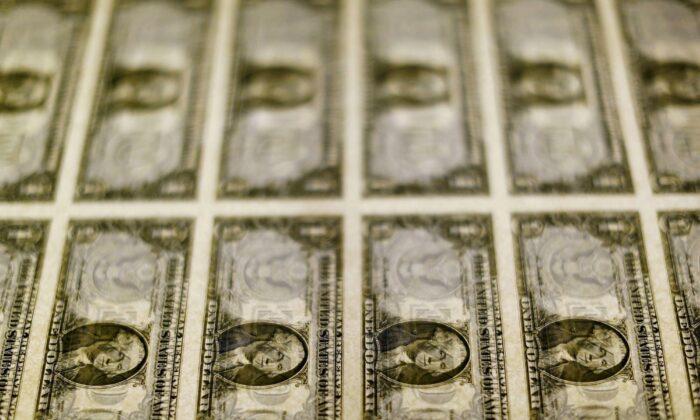LONDON/SINGAPORE—The dollar fell to a two-month low on Thursday after data showed U.S. inflation slowed sharply in March, bolstering speculation the Federal Reserve’s rate hiking campaign is either already finished or will be by May.
As the dollar slipped, the euro rose to within a whisker of a one-year high, with traders betting the European Central Bank’s (ECB) fight against inflation still has a way to go.
Figures released on Wednesday showed U.S. consumer price index (CPI) inflation came at 5 percent year-on-year in March, down from 6 percent in February.
Core inflation—which strips out volatile food and energy prices—picked up to 5.6 percent, from 5.5 percent the previous month.
The dollar dropped after the data was released and weakened further on Thursday, helping the euro rise to a two-month high of $1.1032—just off the one-year peak of $1.1034 touched in early February. The euro was last up 0.2 percent at $1.101.
The dollar index, which measures the greenback against six major peers, fell to 101.2, its lowest since the start of February. It was on track for its fifth straight weekly drop and last stood 0.15 percent lower at 101.33.
“We have seen a dramatic swing in interest differentials in favour of the euro,” said Ben Laidler, global markets strategist at eToro.
Watch Bond Yields
Expectations that interest rates and bond yields will stay high in the eurozone but fall in the U.S. is making the euro look more attractive, analysts said.Minutes from the Fed’s March meeting, also released on Wednesday, showed several officials considered pausing rate hikes after the failure of Silicon Valley Bank. The Fed ended up hiking by 25 basis points (bps) to a range of 4.75 percent to 5 percent.
The eurozone’s main interest rate currently stands at 3 percent.
Eurozone bond yields rose sharply on Wednesday, narrowing the gap between German and U.S. 10-year borrowing costs to its smallest in two years.
The dollar was little changed against Japan’s yen at 133.19, after falling 0.39 percent in the previous session.
New Bank of Japan Governor Kazuo Ueda on Wednesday indicated he was concerned about tightening monetary policy too early and failing to push inflation sustainably to 2 percent.
Britain’s pound hit a 10-month high of $1.253. It was last up 0.2 percent at $1.251, on track for its third straight daily gain.
Data on Thursday showed the British economy stagnated in February as strikes by public sector workers hit output.
Meanwhile, the dollar fell to a 26-month low against the Swiss franc at 0.8898. The franc is traditionally seen as a safe haven at times of stress.
John Hardy, head of FX strategy at Saxo Bank, said he expected the dollar to grind lower from here as inflation cools and the economy slows.
“It encourages dollar weakness, as long as we don’t get a major recession or a major reheating,” Hardy said. “Nothing massive, we’re just looking for an extension of the weakness.”
Pricing in derivatives markets shows traders think there’s a roughly 70 percent chance the Fed will raise rates by 25 bps again in May, and a 30 percent chance it does nothing. They expect rates to fall to around 4.375 percent by the end of the year.
By contrast, traders expect the ECB’s main interest rate to peak at around 3.7 percent by November.





